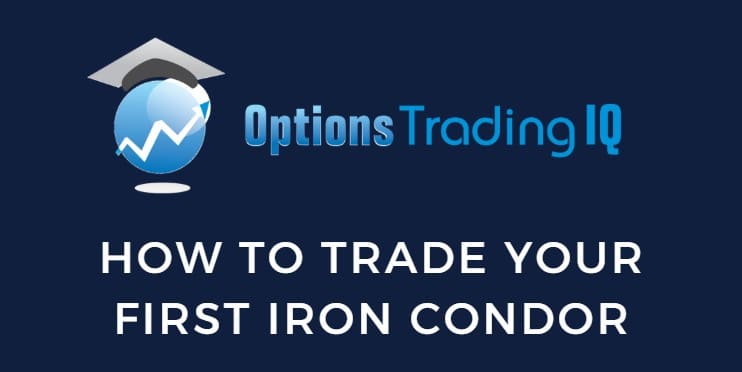
Options trading offers a wide range of strategies for different market conditions, and one of the most popular among income traders is the Iron Condor.
It’s a strategy that appeals to many because it provides defined risk, consistent theta decay, and works best in quiet, range-bound markets.
If you’re just getting started with Iron Condors, this guide will walk you through everything you need to know to build your first one with confidence.
Contents
An Iron Condor is a neutral income trade made up of two credit spreads:
- A short put spread placed below the market
- A short call spread placed above the market
When you sell both spreads, you collect a credit.
That credit represents your maximum profit.
Your risk is capped at the width of the spreads minus the credit received.
This defined-risk structure is one of the biggest reasons traders like Iron Condors.
You know your max gain and max loss upfront, and you benefit from time decay (theta) as long as the stock remains between your short strikes.
Iron Condors are best suited for range-bound markets.
Periods when you don’t expect big price swings.
They work especially well when implied volatility is relatively low and stable.
The ideal underlyings are highly liquid ETFs, such as SPY or QQQ, or large-cap stocks with ample options volume.
Avoid placing Iron Condors ahead of major events, such as earnings reports, Fed announcements, or significant economic data releases, as these can lead to sharp moves that threaten your position.
A good starting point is to look for options with 30 to 45 days to expiration (DTE).
This timeframe provides enough time for theta decay to work in your favor, but it avoids the extreme gamma risk that appears in the final days before expiration.
Longer-term Iron Condors (say 60–90 days) tend to move much more slowly in terms of profit and loss, which may not suit traders who want faster results.
There are two common approaches to strike selection:
1. Delta-based method: Choose your short strikes around the 15-delta level. This provides a reasonable probability of success while still yielding a decent premium.
2. Support and resistance method: Place your short strikes just below key support levels (for puts) and just above resistance levels (for calls).
Many traders combine both approaches, using delta as a guideline but adjusting for technical price levels when appropriate.
Your “wing width” refers to the distance between your short strike and long strike on each side.
- On ETFs like SPY, a simple rule of thumb is to use spreads 5–10 points wide.
- Wider spreads require more margin but also allow you to collect a larger credit.
- Narrower spreads reduce your risk per trade but also reduce the premium collected.
Select a consistent width that aligns with your account size and risk tolerance.
When entering an Iron Condor, you can place it as a single order (all four legs together) or enter each credit spread separately.
Always use limit orders near the mid-price.
Market orders can lead to slippage, which eats into your expected edge.
Liquidity is crucial.
Stick with tickers where the bid/ask spreads are tight.
Proper position sizing can make or break your trading results.
When starting out, a good guideline is to risk no more than 1–2% of your account on a single Iron Condor.
For example:
If the max loss on your trade is $850 and you’re trading a $100k account, then one contract is the appropriate size.
Another key rule: Never let the stock price move beyond your short strikes without taking action.
That’s where losses accelerate.
As you get more experience, you can increase your position size.
Iron Condors work best with proactive exits.
Many traders close their position once they’ve captured 50–75% of the original credit.
For example:
If you collected $1.50 to open, consider closing when the trade is worth $0.75 to $0.50.
This approach helps you avoid the painful gamma risk that builds in the final week before expiration.
Many traders also exit or roll positions when there are about 10–14 days to expiration.
If the stock moves sharply and threatens one side of your Iron Condor, you have several adjustment options:
- Roll the challenged side further away to cut the risk
- Roll the unchallenged side to collect additional credit
- Roll the entire trade out in time to a later expiration
However, avoid over-adjusting.
Sometimes the best choice is to take a small, controlled loss and move on.
Adjustment strategies require practice and a clear plan before entering the trade.
New traders often stumble with Iron Condors because they:
- Trade illiquid underlyings with wide bid/ask spreads
- Risk too much relative to their account size
- Hold positions through earnings or major announcements
- Treat Iron Condors as “set and forget” trades without having exit and adjustment rules
Avoiding these pitfalls is key to long-term success.
The Iron Condor is a powerful options strategy for generating consistent income in neutral markets.
It offers defined risk, steady theta decay, and works well on liquid, range-bound underlyings.
By choosing expirations in the 30–45 day range, carefully selecting strikes, managing risk through proper position sizing, and exiting trades early, you’ll set yourself up with a solid framework.
Like any options strategy, Iron Condors require discipline, patience, and practice.
Have a clear plan for profit-taking and defense before entering, and you’ll be much better prepared to succeed.
We hope you enjoyed this article on how to trade your first iron condor.
If you have any questions, send an email or leave a comment below.
Trade safe!
Disclaimer: The information above is for educational purposes only and should not be treated as investment advice. The strategy presented would not be suitable for investors who are not familiar with exchange traded options. Any readers interested in this strategy should do their own research and seek advice from a licensed financial adviser.

